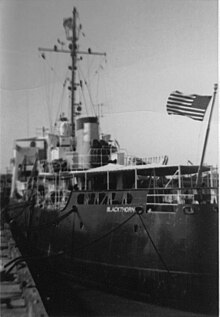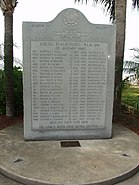| USCGC Blackthorn (WLB-391) | |
|---|---|
 | |
| Career (United States) | |
| Name: | USCGC Blackthorn (WLB-391) |
| Builder: | Marine Ironworks and Shipbuilding Corporation, Duluth, Minnesota |
| Cost: | $876,403 |
| Laid down: | 21 May 1943 |
| Launched: | 20 July 1943 |
| Commissioned: | 27 March 1944 |
| Decommissioned: | 1980 |
| Fate: | Sunk in Accident |
| General characteristics | |
| Class & type: | Iris |
| Displacement: | 935 long tons (950 t) |
| Length: | 180 ft (55 m) |
| Beam: | 37 ft (11 m) |
| Installed power: |
2 × Cooper-Bessemer diesel engines 2 × Westinghouse generators |
| Propulsion: | 1 × electric motor |
| Speed: | 13 kn (24 km/h; 15 mph) maximum |
| Range: | 8,000 nmi (15,000 km; 9,200 mi) at 13 kn (24 km/h; 15 mph) |
| Complement: | 48 |
| Armament: |
Wartime: 1 × 3"/50 caliber single mount 4 × 20 millimeter/80 caliber 2 × depth-charge tracks 2 × mousetrap launchers (1944). Peacetime: None. |
USCGC Blackthorn (WLB-391) was a 180-foot (55 m) seagoing buoy tender (WLB) which sank in 1980 in a collision near the Tampa Bay Sunshine Skyway Bridge, resulting in 23 crew member fatalities.[1][2][3] An Iris-class vessel, she was built by Marine Ironworks and Shipbuilding Corporation in Duluth, Minnesota. Blackthorn's preliminary design was completed by the United States Lighthouse Service and the final design was produced by Marine Iron and Shipbuilding Corporation in Duluth. On 21 May 1943 the keel was laid, she was launched on 20 July 1943 and commissioned on 27 March 1944. The original cost for the hull and machinery was $876,403. Blackthorn was one of 39 original 180-foot (55 m) seagoing buoy tenders built between 1942-1944. All but one of the original tenders, USCGC Ironwood (WLB-297), were built in Duluth. Blackthorn was initially assigned to the Great Lakes for ice-breaking duties, but after only a few months, she was reassigned to San Pedro, California. She served in San Pedro for several years before being brought into the gulf coast region to serve in Mobile, Alabama then transferred to Galveston, Texas for the final years of her service until the accident.
In 1979-1980, Blackthorn underwent a major overhaul in Tampa, Florida. However, on 28 January 1980, while leaving Tampa Bay after the completion of the overhaul, she collided with the tanker SS Capricorn. Shortly after the collision, Blackthorn capsized, killing 23 of her crew.[4] The cutter was raised for the investigation, but ultimately was scuttled in the Gulf of Mexico after the investigation was complete. She currently serves as an artificial reef for recreational diving and fishing.
The Accident[]
Having just completed her overhaul at the Gulf Tampa Drydock Company, which included overhaul of the main propulsion generators, Blackthorn was outward bound from Tampa Bay on the night of 28 January 1980. Meanwhile the tanker Capricorn, owned by Kingston Shipping Company and operated by Apex Marine Corporation of New York, was standing (traveling with right-of-way) into the bay. Blackthorn's captain, Lieutenant Commander George Sepel had departed the bridge to investigate a problem with the newly installed propulsion shaft. Ensign John Ryan had the conn.
Earlier they had been overtaken by the Russian passenger ship Kazakhstan, Blackthorn pulled to the side to allow her to pass, when requested, and then continued almost in mid-channel. Some contend that the brightly lit passenger vessel obscured the ability of the crews of Blackthorn and Capricorn to see each other.
Capricorn began to turn left, but this would not allow the ships to pass port-to-port. Unable to make radio contact with Blackthorn, Capricorn's pilot blew two short whistle blasts to have the ships pass starboard-to-starboard. With the officer of the deck confused in regard to the standard operating procedure, Blackthorn's captain issued orders for evasive action. Though collision was imminent, initial damage was not extensive. However, Capricorn's anchor was ready to be let go. The anchor became embedded in the Blackthorn's hull and ripped open the port side above the water line. Then as the two ships backed away from each other, the chain became taut. The force of the much larger ship pulling on it, caused Blackthorn to tip on her side until she suddenly capsized. Six off-duty personnel who had mustered when they heard the collision alarm, were trapped inside the ship. Several crew members who had just reported aboard tried to escape and in the process trapped themselves in the engine room. Though 27 crewmen survived the collision, 23 perished. In the end the primary responsibility for the collision was placed with Commander Sepel as he had permitted an inexperienced junior officer to conn the ship in an unfamiliar waterway with heavy traffic. The Commandant of the United States Coast Guard, Admiral John B. Hayes, approved the report of the marine board of investigation on the collision between Blackthorn and Capricorn. The board determined that the cause of the casualty was the failure of both vessels to keep well to that side of the channel which lay on their starboard (right) side. Concurring with the marine board's determination of the cause, the Commandant emphasized in his "Action" that the failure of the persons in charge of both vessels to ascertain the intentions of the other through the exchange of appropriate whistle signals was the primary contributing cause. Additionally, Admiral Hayes pointed out that attempts to establish a passing agreement by using only radiotelephone communications failed to be an adequate substitute for exchanging proper whistle signals. The collision occurred in the evening of 28 January 1980, near the junction of Mullet Key and Cut "A" Channels approximately three-quarters of a mile from the Sunshine Skyway Bridge in Tampa Bay. The vessels collided nearly head on, and as a result, Capricorn's port anchor became embedded in Blackthorn's port side. The momentum of the two vessels caused Capricorn's anchor chain to become taut which resulted in the Blackthorn's capsizing. Capricorn subsequently ran aground north of the channel and Blackthorn sank in the channel. Twenty-seven of the 50 Blackthorn crew members were rescued. The marine board found evidence of violation of various navigation laws on the parts of Capricorn's master and pilot. There were similar findings on the part of Blackthorn's commanding officer and officer of the deck. These matters were referred to the commanders of the Seventh and Eighth Coast Guard Districts for further investigation and appropriate action. The Commandant also acted on various safety recommendations made by the marine board concerning training and equipment aboard Coast Guard vessels, and navigation considerations in Tampa Bay.
Seaman Apprentice William "Billy" Flores[]
Seaman Apprentice William "Billy" Flores was originally from Carlsbad, New Mexico and a graduate of Arlington Heights High School in Fort Worth, Texas. In 2000 he was posthumously awarded the Coast Guard Medal, the service's highest award for heroism in peacetime.[5][6] SA Flores, who had been out of boot camp just one year, opened the life jacket locker as Blackthorn capsized, securing its hatch open with his belt, and made sure that his shipmates were able to access and use the life jackets. His actions saved a number of lives during the accident. His heroic role was initially overlooked by the two official reports by the Coast Guard and the NTSB, but was later given the recognition he deserved. His family was presented with the Medal on 28 January 2000, the 20th anniversary of the tragedy. Seaman Apprentice Flores died aboard Blackthorn. In October 2010, it was announced that the third new Sentinel-class fast response cutter, a 154 foot patrol boat, would be named for Flores.[7]
Gallery[]
References[]
- ↑
McMahon, Patrick (7 February 1980). "'Hard right rudder': 'Blackthorn' skipper gave command too late, crewman testifies". p. 1B. http://news.google.com/newspapers?id=FuQnAAAAIBAJ&sjid=PVoDAAAAIBAJ&pg=5487%2C4950715.
McMahon, Patrick (7 February 1980). "'Hard right rudder' (continued)". p. 8B. http://news.google.com/newspapers?id=FuQnAAAAIBAJ&sjid=PVoDAAAAIBAJ&pg=6801,5003607. - ↑ McBride, Don (8 February 1980). "'Blackthorn' Skipper and Tampa Pilot Main Marine Board Weekend Witnesses". p. 18-A. http://news.google.com/newspapers?id=UWdQAAAAIBAJ&sjid=qFgDAAAAIBAJ&pg=5047,2072390&hl=en. Retrieved 2011-12-02.
- ↑ McBride, Don (9 February 1980). "Skipper Pleads Fifth Amendment; Attorney Requests Immunity". http://news.google.com/newspapers?id=UmdQAAAAIBAJ&sjid=qFgDAAAAIBAJ&pg=7108,2497103&hl=en. Retrieved 2011-12-02.
- ↑ Barnette, Michael C. (2008). Florida's Shipwrecks. Arcadia Publishing. pp. 122, 123. ISBN 978-0-7385-5413-6.
- ↑ Sources cite both "Willy" and "Billy" as nicknames
- ↑ "Getting his due Coast Guard hero receives honor posthumously". 17 September 2000. http://nl.newsbank.com/nl-search/we/Archives?p_product=ST&s_site=dfw&p_multi=ST&p_theme=realcities&p_action=search&p_maxdocs=200&p_topdoc=1&p_text_direct-0=0EAF9298B7BF1FC5&p_field_direct-0=document_id&p_perpage=10&p_sort=YMD_date:D&s_trackval=GooglePM. Retrieved 2011-12-02.
- ↑ Vaughn, Chris (29 November 2011). "New CG Cutter Named for Local Hero". Archived from the original on 2011-12-02. http://www.webcitation.org/query?url=http%3A%2F%2Fwww.star-telegram.com%2F2011%2F11%2F26%2F3552733%2Fnew-coast-guard-cutter-bears-name.html&date=2011-12-02. Retrieved 2011-12-02.
External links[]
- USCG Blackthorn history webpage
- National Park Service Report on the 180-foot (55 m) buoy tenders
- "U.S. Coast Guard Sea-going & Coastal Buoy Tenders, 1939-2000". http://www.uscg.mil/history/WEBCUTTERS/WLB_Photo_Index.asp.
- Article about 20th Anniversary of the sinking
- Coast Guard photos of Blackthorn
| ||||||||||||||
The original article can be found at USCGC Blackthorn (WLB-391) and the edit history here.


